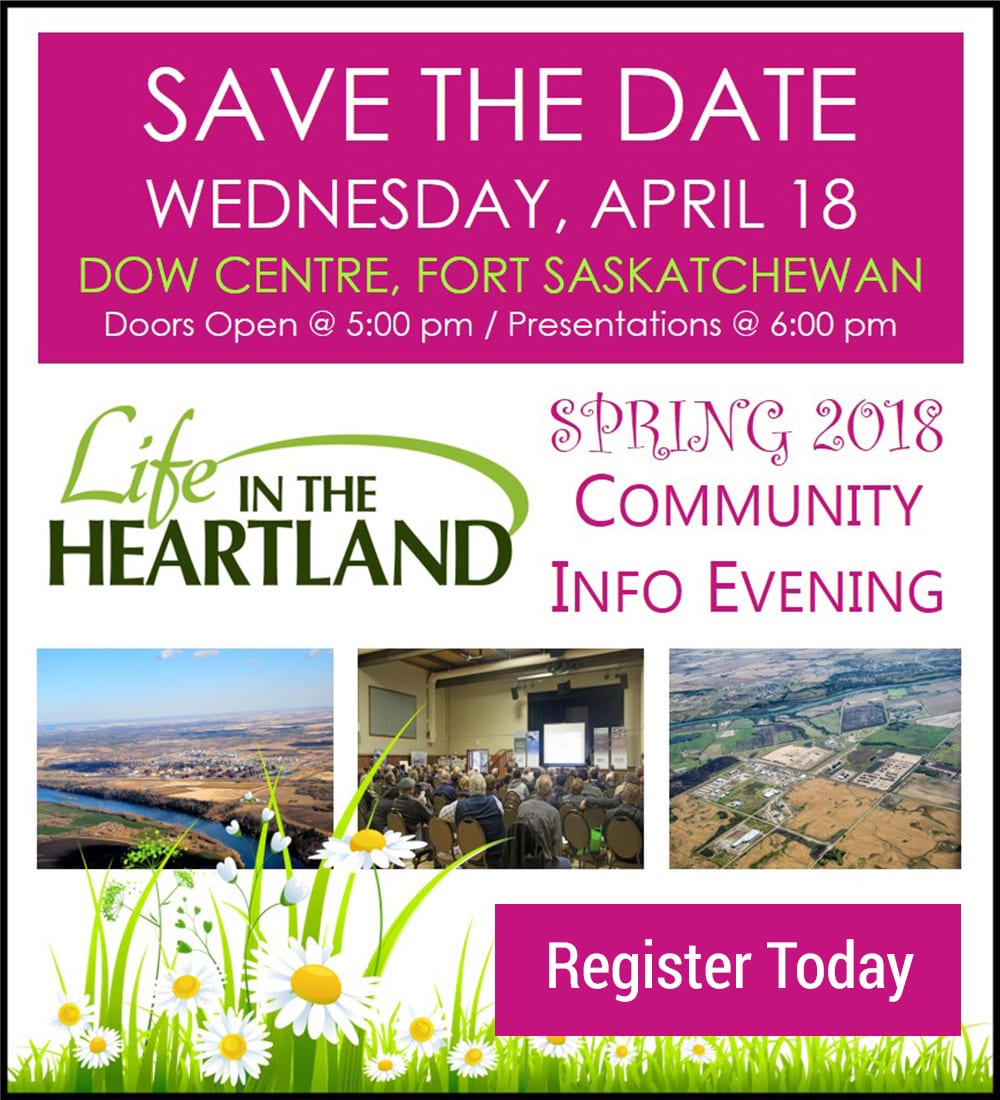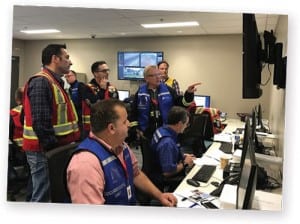Newsletter: Spring 2018
[cs_content][cs_section parallax=”false” separator_top_type=”none” separator_top_height=”50px” separator_top_inset=”0px” separator_top_angle_point=”50″ separator_bottom_type=”none” separator_bottom_height=”50px” separator_bottom_inset=”0px” separator_bottom_angle_point=”50″ style=”margin: 0px;padding: 0px;”][cs_row inner_container=”false” marginless_columns=”false” style=”margin: 0px auto;padding: 0px 0px 20px;”][cs_column fade=”false” fade_animation=”in” fade_animation_offset=”45px” fade_duration=”750″ type=”1/1″ style=”padding: 0px;”][cs_text]
Newsletter: Spring 2018
Survey Results Reveal Trends and Shifting Priorities for Heartland Residents
[/cs_text][x_image type=”none” src=”https://lifeintheheartland.com/wp-content/uploads/2018/04/photo_newsletter_201804_survey.jpg” alt=”” link=”false” href=”#” title=”” target=”” info=”none” info_place=”top” info_trigger=”hover” info_content=””][x_columnize]Residential interest in industrial activity in and around Alberta’s Industrial Heartland is down slightly from 2015, according to a 2017 survey conducted by Life in the Heartland. Overall, 69% of respondents follow industrial activities very or somewhat closely compared to 76% in 2015.
A telephone poll of 400 residents from Alberta’s Industrial Heartland and surrounding region was conducted in 2017 to determine public perceptions about industry and environment-related topics, how closely residents follow industrial development, and preferred sources of information. The data was compared to a similar survey conducted in 2015.
Respondents felt infrastructure and air quality were the most importance issues facing the region, followed by traffic and jobs. When compared to 2015, air quality, traffic and environmental concerns dropped, infrastructure remained the same, and the economy emerged as a prominent issue.
“Tracking resident perceptions and issues provides valuable insight on trends and shifting priorities for the Industrial Heartland community,” says Tracey Hill, Chair of Life in the Heartland. “Our ability to identify emerging issues, like the economy, in addition to a sustained trend in environmental topics, helps us continue to provide relevant information to our audience and helps to guide our engagement activities.”
When asked where they obtain information, respondents selected local newspapers as their preferred source, with local television ranking second. The internet/social media saw a remarkable 9% increase over 2015 – more than 39% of respondents indicated that social media is an important source for local and regional information.
Air quality remains a top issue for respondents. More than 60% rated air quality where they live as excellent or good, up 3% from 2015, while approximately 27% rated the air quality as average.
Seventy-four percent (74%) of respondents indicated an interest in safety/emergency response issues and 43% of all respondents indicated that local media would be their primary information source regarding an emergency situation that impacted public safety. This is on par with 2015 survey results.[/x_columnize][/cs_column][/cs_row][cs_row inner_container=”false” marginless_columns=”false” style=”margin: 0px auto 20px;padding: 0px;”][cs_column fade=”false” fade_animation=”in” fade_animation_offset=”45px” fade_duration=”750″ type=”1/3″ style=”padding: 0px;”][x_image type=”none” src=” ” alt=”” link=”true” href=”https://www.surveymonkey.com/r/LITHApril18″ title=”” target=”blank” info=”none” info_place=”top” info_trigger=”hover” info_content=””][/cs_column][cs_column bg_color=”rgb(158, 158, 158)” fade=”false” fade_animation=”in” fade_animation_offset=”45px” fade_duration=”750″ type=”2/3″ style=”padding: 20px;color: #fff;”][cs_text]
” alt=”” link=”true” href=”https://www.surveymonkey.com/r/LITHApril18″ title=”” target=”blank” info=”none” info_place=”top” info_trigger=”hover” info_content=””][/cs_column][cs_column bg_color=”rgb(158, 158, 158)” fade=”false” fade_animation=”in” fade_animation_offset=”45px” fade_duration=”750″ type=”2/3″ style=”padding: 20px;color: #fff;”][cs_text]

The Northeast Capital Industrial Association 2017 Report to the Community is now available. Read the report.[/cs_text][/cs_column][/cs_row][cs_row inner_container=”false” marginless_columns=”false” style=”margin: 0px auto 20px;padding: 0px;”][cs_column fade=”false” fade_animation=”in” fade_animation_offset=”45px” fade_duration=”750″ type=”2/3″ style=”padding: 20px 0px 0px;”][cs_text]
Resident Emergency Readiness in the Heartland

Alberta is home to the top 10 costliest disasters in Canada’s history. Floods, fires and severe weather events affecting hundreds of thousands of Albertans are all recent occurrences. If an emergency happened close to home, would you and your family be prepared?
A recent Life in the Heartland survey asked residents in the region about their overall emergency preparedness. “We wanted to obtain a snapshot of how ready people in our local communities are for emergencies,” says Brenda Gheran with local mutual aid group Northeast Region Community Awareness Emergency Response (NRCAER), a partner in the Life in the Heartland initiative. “The survey results give us insight and help identify where safety education efforts should focus.”
- 85% of respondents were very or somewhat prepared to look after their household’s immediate needs for 72 hours.
- 54% of respondents were very or somewhat prepared to evacuate with an emergency kit of essentials ready to go.
- 37% of respondents were aware of the Shelter in Place safety action, a 6% increase over 2015 results.
Emergency Preparedness Week occurs May 6 – 12th. There are free and easy to use resources available for individuals and families to build a basic emergency plan on the Alberta Emergency Management Agency website and the Alberta Emergency Alert app.
“In many cases, people only think about emergencies when they are experiencing them,” says Gheran. “An effective response relies on each of us taking time before an emergency occurs, to know the risks, make a plan and have a kit.”[/cs_text][/cs_column][cs_column bg_color=”rgb(25, 117, 113)” fade=”false” fade_animation=”in” fade_animation_offset=”45px” fade_duration=”750″ type=”1/3″ style=”padding: 20px;color: #fff;”][cs_text style=”color: #fff;”]
Fort Air Partnership Upcoming Events
When: Monday, May 7, 3:00 – 6:00 PM
Where: Redwater Legion, 4708 – 50 Avenue in Redwater
What: A celebration of the opening of Fort Air Partnership’s new air quality monitoring station in Redwater. Includes tours and a short Annual General Meeting.
RSVP: Interested in attending? Please let us know.
When: Monday, June 11, 4:00 – 6:00 PM
Where: Bon Accord, 4803 – 49 Street
What: Official opening and tours of Fort Air Partnership’s first portable air quality monitoring station.
RSVP: Interested in attending? Please let us know.[/cs_text][x_image type=”none” src=”https://lifeintheheartland.com/wp-content/uploads/2017/10/photo_newsletter_201710_logo_fap.png” alt=”” link=”false” href=”#” title=”” target=”” info=”none” info_place=”top” info_trigger=”hover” info_content=””][/cs_column][/cs_row][cs_row inner_container=”false” marginless_columns=”false” style=”margin: 0px auto 20px;padding: 0px;”][cs_column fade=”false” fade_animation=”in” fade_animation_offset=”45px” fade_duration=”750″ type=”1/2″ style=”padding: 0px;”][cs_text]
2017 Regional Air Quality Monitoring Results Released
Fort Air Partnership (FAP), the organization that monitors the air local residents breathe, recently released its 2017 regional air quality monitoring results.
In 2017, FAP’s six stations that collect data used to calculate an hourly and forecast Air Quality Health Index (AQHI) in and around Alberta’s Industrial Heartland registered low risk readings the vast majority of the time. Lamont County had the highest annual percentage of low risk readings at 98% while Fort Saskatchewan had the lowest at 93%. Risk to health increases as the index level rises. Go to fortair.org for more information.
In total across the network, 43,014 hours of AQHI readings were recorded in 2017. Of that total, 57 hours (or less than 0.2% of total hours monitored) were in the high or very high risk AQHI category. These were due mainly to forest fire smoke or winter temperature inversions. During a winter inversion, cold air along with pollutants is trapped near the ground by a layer of warm air. This is a weather condition that impacts large parts of the Edmonton Metropolitan Region whenever it occurs.
During 2017, there were 146 occasions across FAP’s nine monitoring stations where air quality measurements exceeded Alberta’s Ambient Air Quality Objectives. Two-thirds (67%) of these exceedances involved high concentrations of Respirable Particulate Matter (PM2.5). The PM2.5 exceedances were caused mainly by forest fire smoke and winter temperature inversions.
Five year trends of both AQHI and exceedances show fluctuations. This can be attributed to variances in annual seasonal events like forest fires, weather patterns and FAP’s transition over the last five years to a regional monitoring network that more accurately monitors air quality where people live.
Local residents can check the forecast and daily AQHI at fortair.org. The website also has a live data feed of a variety of substances FAP measures, and weekly, quarterly and annual statistical results.[/cs_text][/cs_column][cs_column bg_color=”rgb(240, 240, 240)” fade=”false” fade_animation=”in” fade_animation_offset=”45px” fade_duration=”750″ type=”1/2″ style=”padding: 15px 20px 0px;border-style: solid;border-width: 1px;border-color: rgb(79, 79, 79);”][cs_text]
Air Quality Health Index (AQHI) Ratings
The AQHI describes the level of health risk associated with an AQHI number. The levels are low, moderate, high or very high. The higher the index number, the greater the health risks. Six of FAP’s nine continuous air monitoring stations measure the substances required to calculate the AQHI.
2017 Air Quality Health Index Ratings
| Risk Level (% of time) | |||||
|
Station Name |
Hours Monitored |
Low |
Moderate |
High |
Very High |
| Bruderheim |
8,465 |
97.68% |
2.16% |
0.15% |
0.00% |
| Elk Island |
8,166 |
97.07% |
2.78% |
0.11% |
0.04% |
| Fort Saskatchewan |
8,056 |
93.05% |
6.93% |
0.02% |
0.00% |
| Gibbons |
8,493 |
94.97% |
4.83% |
0.15% |
0.05% |
| Lamont County |
8,431 |
98.11% |
1.73% |
0.15% |
0.00% |
| Redwater* |
1,403 |
97.36% |
2.64% |
0.00% |
0.00% |
| Total hours |
43,014 |
41,396 |
1,561 |
50 |
7 |
| Risk Level (# of hours) | |||||
|
Station Name |
Hours Monitored |
Low |
Moderate |
High |
Very High |
| Bruderheim |
8,465 |
8,269 |
183 |
13 |
0 |
| Elk Island |
8,166 |
7,927 |
227 |
9 |
3 |
| Fort Saskatchewan |
8,056 |
7,496 |
558 |
2 |
0 |
| Gibbons |
8,493 |
8,066 |
410 |
13 |
4 |
| Lamont County |
8,431 |
8,272 |
146 |
13 |
0 |
| Redwater* |
1,403 |
1,366 |
37 |
0 |
0 |
| Total hours |
43,014 |
41,396 |
1,561 |
50 |
7 |
*The new Redwater station began operating in October, 2017 but did not start reporting the AQHI until November 1.[/cs_text][/cs_column][/cs_row][cs_row inner_container=”false” marginless_columns=”false” bg_color=”rgb(240, 240, 240)” style=”margin: 0px auto 20px;padding: 0px 20px;border-style: solid;border-width: 1px;”][cs_column fade=”false” fade_animation=”in” fade_animation_offset=”45px” fade_duration=”750″ type=”1/1″ style=”padding: 0px;”][cs_text]

Alberta’s Industrial Heartland Association Turns 20
By Tracey Hill, Manager of Communications and Community Relations, Alberta Industrial Heartland Association [/cs_text][x_columnize]2018 marks the 20th anniversary of Alberta’s Heartland Industrial Association. As we look back at our Association’s history, we reflect on all that the Association has achieved over those years and we are proud of the work we’ve done to attract investment, to drive energy diversification, and to promote innovative business solutions.
Twenty years ago, the municipalities of the City of Fort Saskatchewan, Lamont County, Strathcona County and Sturgeon County recognized the opportunity afforded them by their unique location in the province. We created a partnership dedicated to strengthening sustainable industrial development that benefits the residents and businesses in our municipalities. With the addition of the City of Edmonton in 2010 and three Associate members – Bruderheim, Gibbons and Redwater in 2011 – the Association continues to demonstrate the value of that cooperation.
As a result, more than $40 billion in capital has been invested in the region, realizing significant returns to the economy of Alberta and to the communities in the Heartland region. We are recognized globally for our ability to attract investment and make valuable community connections. As well, in the past 20 years we have seen tremendous growth in the Industrial Heartland, which is reflected in our tremendous economic impact and thousands of jobs created.
Although in recent years Alberta has faced economic challenges, our Association has advocated tirelessly for programs that enhance investment, maximize diversification opportunities, and position our region as a leader in petrochemical development. Specifically, these efforts have seen the development of the Government of Alberta’s Petrochemical Diversification Program, the completion of the North West Redwater Refinery, the announcement of Inter Pipeline’s Heartland Petrochemical Complex and the proposal of a second new propane processing facility, all of which will diversify our energy exports and contribute to sustainable growth in the region.
So much benefit has been derived from our commitment to our original vision in the region and we will continue to focus our efforts on partnerships with industry, community, and government stakeholders.
With the collaboration, innovation and diversification that have resulted from these partnerships, Alberta and the Heartland region can continue to look forward to a bright, sustainable future. Visit our website at www.IndustrialHeartland.com to learn more.[/x_columnize][/cs_column][/cs_row][cs_row inner_container=”false” marginless_columns=”true” bg_color=”rgb(25, 117, 113)” style=”margin: 0px auto;padding: 10px 20px;color: #fff;”][cs_column fade=”false” fade_animation=”in” fade_animation_offset=”45px” fade_duration=”750″ type=”1/1″ style=”padding: 20px 20px 0px;”][cs_text]
Heartland Gears Up for Turnaround Season
[/cs_text][/cs_column][/cs_row][cs_row inner_container=”false” marginless_columns=”true” bg_color=”rgb(25, 117, 113)” style=”margin: 0px auto;padding: 10px 20px;color: #fff;”][cs_column fade=”false” fade_animation=”in” fade_animation_offset=”45px” fade_duration=”750″ type=”1/1″ style=”padding: 20px 20px 0px;”][x_columnize]It is that time of year again when facilities in Alberta’s Industrial Heartland take advantage of spring weather. For many companies, spring signals the start of turnaround season and the continuation of construction projects.
Maintenance Is a Must
Just like your vehicle and home, industrial facilities require regular maintenance to keep them operating safely and efficiently. Companies schedule turnarounds to decrease or stop production so that certain maintenance tasks can be completed. Depending on the facility, a turnaround can last as short as a few days, or up to a month or longer.
The work completed during a turnaround involves equipment inspections and, if necessary, repairs, replacements, and technology upgrades. Particularly on older facilities, new technology can improve an operation’s environmental performance and help increase productivity.
Impact of Industrial Activity
Construction and turnarounds generate additional local spending on goods and services. They also create employment, as extra manpower is required to complete these projects. This added manpower may result in a noticeable increase in traffic on local highways. Turnarounds may also generate additional noise or visible activity as maintenance work is completed.
Curious About What You See, Hear or Smell?
Many companies use the UPDATEline to keep the community informed about turnaround and construction activities. Call the UPDATEline at 1.866.653.9959 to access pre-recorded messages about industry activity 24 hours a day.

Notable Turnarounds and Construction
Construction activities at North West Redwater Partnership’s Sturgeon Refinery site are expected to be complete this spring with commissioning and start-up activities running throughout the summer. Companies with planned turnarounds this year include:
Spring (March/April/May)
- Air Liquide
- Aux Sable
- Evonik
- Nutrien Fort Saskatchewan
- Shell Scotford
Summer (June/July/Mid-August)
- Keyera Energy
- Nutrien Fort Saskatchewan
- Oerlikon Metco
- Sherritt International
- Umicore
Fall (Late-August/September/October)
- Access Pipeline
- Nutrien Redwater
- Umicore
- Shell Scotford
For more information about Life in the Heartland, follow us on Twitter and Facebook, or email info@lifeintheheartland.com.[/x_columnize][/cs_column][/cs_row][cs_row inner_container=”false” marginless_columns=”false” style=”margin: 0px auto;padding: 0px;”][cs_column fade=”false” fade_animation=”in” fade_animation_offset=”45px” fade_duration=”750″ type=”1/1″ style=”padding: 0px;”][cs_text style=”padding-bottom: 20px;”]
Construction Nearly Complete on Sturgeon Refinery
[/cs_text][x_image type=”none” src=” ” alt=”” link=”false” href=”#” title=”” target=”” info=”none” info_place=”top” info_trigger=”hover” info_content=””][x_columnize]The construction workforce at the Sturgeon Refinery site is on the final push toward completion. Finishing construction is the next big milestone on the way to full operations.
” alt=”” link=”false” href=”#” title=”” target=”” info=”none” info_place=”top” info_trigger=”hover” info_content=””][x_columnize]The construction workforce at the Sturgeon Refinery site is on the final push toward completion. Finishing construction is the next big milestone on the way to full operations.
The refinery is made up of ten large units. Eight of the ten are constructed and in various stages of commissioning and start up. Each unit has a team of experienced personnel to ensure the equipment is running properly, procedures are validated, and performance is monitored. Cold weather during the winter months provided key learnings to ensure the refinery is ready for operating efficiently throughout Alberta’s four seasons.
The two units still under construction include the LC Finer, which processes some of the heaviest fractions of bitumen, as well as the gasifier, which collects CO₂ produced in the refining process, reducing the carbon footprint of the end product. Remaining work on these two units mainly includes electrical heat tracing, insulation, and scaffolding. Target completion is this spring, at which time commissioning and start up will be the focus.
Diesel Production Milestone Achieved
This past December, the Sturgeon Refinery celebrated the production of first diesel. Final product began shipping through pipeline to Pembina just south of the refinery for distribution to customers via truck and rail.
At the current stage of construction, the refinery is able to process synthetic crude oil into diesel and other value added products. As part of commissioning and start up, a partially upgraded feedstock such as synthetic crude allows for testing and adjustments in the units that are functioning. Once the refinery is fully operational, it will use bitumen feedstock to complete the entire refining process from start to finish.
Over 50 million Hours Logged at Refinery
Since 2011, over 50 million hours have been worked on the project. For the average person who works a regular 40 hour week for 52 weeks a year, it would take over 24,000 years to work that many hours. At peak construction, over 8,000 workers were on site every day, with that number dropping to approximately 2,500 people per day currently. The majority of those are involved in finishing construction activities. Various positions required for long term operations still need to be hired, though most of the 400+ people are already in place.
With a substantial decrease in workforce numbers, the bussing program came to an end in December. All totalled, the kilometres logged by the busses equal over 350 trips around the earth – that’s one per day for nearly a year.
Community Investment Benefits Local Museum, Schools and Community Associations
Nearby communities continue to benefit from the proceeds of NWR’s recycling program. Recent charitable donations provided new technology for schools, upgrades for museum, better facilities for rural community association, funds for family programming, and Christmas gifts for children from Alexander First Nation. Details on applying for funding: www.nwrsturgeonrefinery.com.[/x_columnize][/cs_column][/cs_row][/cs_section][/cs_content]

